(2000) 6 - EUR-Lex
(2000) 6 - EUR-Lex
(2000) 6 - EUR-Lex
You also want an ePaper? Increase the reach of your titles
YUMPU automatically turns print PDFs into web optimized ePapers that Google loves.
A <strong>EUR</strong>OPEAN RESEARCH AREA 61. A STOCK OF MATERIAL RESOURCES AND FACILITIES OPTIMISED AT THE <strong>EUR</strong>OPEANLEVEL1.1. Networking of centres of excellence and creation of virtual centresWorld class centres of excellence exist in practically all areas and disciplines in Europe. Theirexact specialities, however, are not always sufficiently well known outside the frontiers of thecountry in which they are established, especially by companies, which could usefully joinforces with them. One of the criteria generally used to define the centres of excellence is theircapacity to produce knowledge that can be used for industrial purposes.Many problems of basic and applied research also need both a critical mass of financial andhuman resources and the combination of complementary expertise from specialists in otherdomains.Mapping of European centres of excellence would make for better transparency in thisarea. A very high level of performance could also be achieved by the networking ofspecialist centres throughout the countries of the Union. The forms of teleworking whichelectronic networks permit make it possible to create real “virtual centres of excellence”, inparticular multidisciplinary and involving universities and companies.To promote excellence, however, it is also necessary to ensure a sufficient level ofcompetition between private and public research operators. Schemes to finance centres ofexcellence on the basis of competition have been put in place in several Member States.This formula could be applied to the European level, with collaboration between theCommission and the Member States.1.2. Defining a European approach to research infrastructuresResearch infrastructures play a central role in the progress and application of knowledge inEurope. Radiation sources, computer centres and databases on molecular biology, forexample, are operated increasingly by research teams from the public and private sectors.Facilities of this kind exist in all the Member States. Construction costs are high, oftenbeyond the capacities of a single country, as are operating costs. And their potential is notalways maximised.Large-scale infrastructures have been constructed and are now being operated at Europeanlevel. Furthermore, assessment of the need for new facilities is often made in a bilateral ormultilateral framework. For its part, the European Union, has, for several years, beenoperating a programme of support for research infrastructures. So far measures within thisframework have been restricted to providing support for transnational access to facilities, forthe development of new instruments and equipment and for cooperation projects designed toimprove the interoperability of installations and the complementarity of their activities.What should be done now is to go a step further and develop a European approach toinfrastructures, covering both the creation of new installations, the functioning of existing6The list of possible themes for action is contained in Annex I.10
















